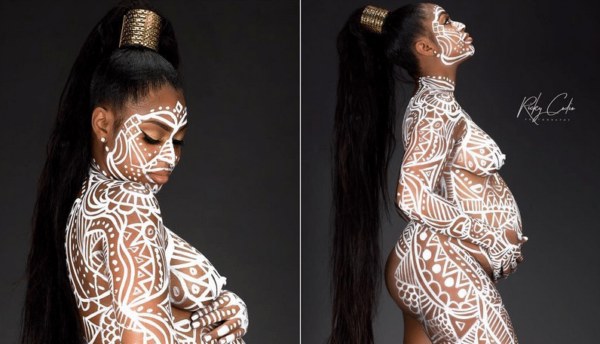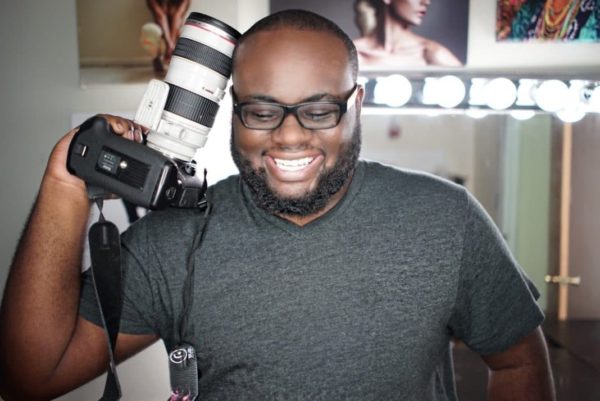The couples in his wedding photos look unhurried, as if they naturally arranged themselves into photogenic positions. Perhaps it is his quiet yet confident demeanor that allows his subjects to feel at ease while he observes from behind the camera lens. Whether staged or organic, Ricky Codio’s wedding photos are reminiscent of fairy tales and they are only one style in a canon of creative photography.
The Philadelphia-based visual artist and owner of The Mannequin Factory has captured the attention of the media industry and television influencers alike. Codio took photos of Michael B. Jordan and Sylvester Stallone for “Creed,” captured visuals with local Little League baseball pitcher Mo’Ne Davis, as well as TV personality Taranasha “Tara” Wallace from “Love & Hip Hop.” His shots of Tara Wallace dipped in gold and draped in giant angel wings attracted the spotlight on social media, lifting him into the public view as a photographer to watch. He’s even been featured on Black Enterprise’s 2016 100 Men of Distinction list. But Codio came a long way from Port-au-Prince, Haiti, to become the young man he is today.

Maternity photos by Ricky Codio (Instagram)
When Ricky Codio picked up a camera eight years ago, he had no intention of walking the path to become a master photographer and owner of The Mannequin Factory. In fact, he stumbled onto his craft by accident. At 18, the aspiring screenwriter walked up to a Philadelphia nightclub with his legal drinking-aged friends, posing as an event photographer with a camera borrowed from his brother. If he played it cool like he was expected to be there, he could pass without ID and be granted entry into what he thought was a networking event.
Whether it was luck, fate, or destiny, Codio’s natural reserve worked in his favor that evening. The habitual creative took to the near-instant gratification that photography awards. He appreciated that, like screenwriting, he could tell stories through the medium. It did not hurt that the event’s creators approved of his work so much that they paid him to return and take pictures for the next party. Two parties led to three, and three parties led to four. Soon, Codio would evolve from looking like a photographer to becoming a master of his craft.
After graduating from Imhotep Institute Charter High School in Philadelphia’s West Oak Lane neighborhood, Codio left the party promoting business behind and focused on his dream — writing manuscripts for film and television. He squeezed in time to write between shifts at his job at a wireless retail store and enrolled in courses for screenwriting at the Art Institute of Philadelphia. Although the coursework was stimulating, the pace was not quick enough for the artist. He noticed that he was spending a lot more time taking inessential classes than focusing on either screenwriting or camera work. “When I realized it wasn’t going to be that, I thought ‘let me just teach myself,’” said Codio. He picked up the camera again and went back to familiar territory, deciding to master photography and gain the creative control necessary to become an entrepreneur.

Photographer Ricky Codio
The Mannequin Factory
With his sights set on becoming a studio owner by 25, Codio worked photography jobs and networked persistently. He envisioned himself owning a space where other creatives could work individually and collectively — the type of studio he wished had existed when he was a novice shutterbug. Although the photographer has held studio space in the past, those spaces were always procured through investors who had the final word about the management, look and feel of the spaces. At exactly the age of 25, Codio manifested his dreams and created a base of operations for his personal team with plenty of room to spare for creatives who need affordable, high-quality studio space — all under his creative control.

“If I had this kind of facility, this opportunity, I would be in a different position by now,” Codio mentioned.
Journeying into entrepreneurship and opening The Mannequin Factory has taught Codio many life lessons. Learning how to become assertive, how to price his services and valuing his time are all major lessons that shaped Codio as a businessman. When thinking about advice to give budding entrepreneurs, Codio recalled one particularly hard lesson — securing deposits.
“Once, I traveled all the way to New York for a job that I hadn’t received a deposit for. I went, did the photoshoot and did not get paid.” Codio is big on mentorship, and he feels it’s part of his mission to mentor up-and-coming artists so they do not make the same mistakes he did when they are starting out. “Another important piece of advice: Saving is crucial because rainy days happen all the time and you have to be sure that you’re prepared.”

When thinking about his most exciting creative project, Codio recalls his experience working alongside Ryan Coogler and Michael B. Jordan on the set of “Creed.” It was a special experience that allowed him to see how movies are shot and reinvigorated his passion for screenwriting. Although he loves creative photography and plans to open up more studios in the future, he still has not given up on that dream.
“I’m working consistently, things are going so well and everything is amazing right now … but I still love screenwriting, and I want to go back to it eventually.”

